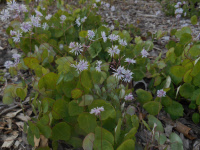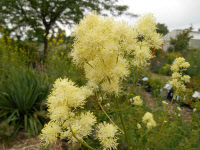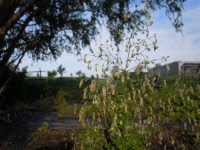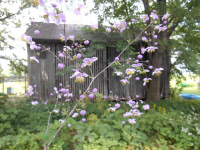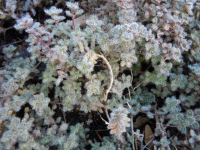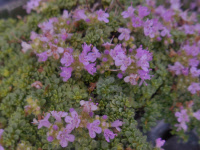Our Plants
Showing 577–584 of 616 results
-
Thalictrum ichangense Dwarf meadowrue, Chinese meadowrue, in China called “dun ye tang song cao” Z 5-7
Airy sprays of palest of pink flowers in early summer & sporadically reblooming. Pretty foliage - flushed with purple and marbled grey, think Begonia leaves.
Airy sprays of palest of pink flowers in early summer & sporadically reblooming. Pretty foliage – flushed with purple and marbled grey, think Begonia leaves.
Size: 6” x 6”
Care: shade to part shade in moist well-drained soil
Native: forests and damp rocky ledges in Western ChinaDescribed in literature 1888. Collected for the West by Augustine Henry (1857-1930) Irishman who went to China as a physician in the Imperial Maritime Customs Service and stayed 20 years hunting the plants of central China. He collected about 5000 new plants. Used in traditional Chinese medicine.
The species name ichangense comes from the province of Ichang where Dr. Henry found this. -
Thalictrum lucidum Shining meadowrue Z 4-8
In midsummer creamy, fluffy puffs, smelling of roses, atop dark green leaves. Tall, dark & handsome.
In midsummer creamy, fluffy puffs, smelling of roses, atop dark green leaves. Tall, dark & handsome.
Size: 3-6’ x 20”
Care: sun to part shade, moist to moist well drained soil
Native: France & Spain
Awards: Rated as excellent by the Chicago Botanic Garden.Thalictrum is from Greek meaning “to flourish” or “look green.” Lucidum means “bright, shining.” This species collected before 1736.
-
Thalictrum minus ‘Adiantifolium’ Fernleaf meadowrue Z 4-8
Loose panicles of tiny yellowish flowers top fern-like foliage in mid-summer.
Loose panicles of tiny yellowish flowers top fern-like foliage in mid-summer.
Size: 36" x 24"
Care: part shade in moist to moist well-drained soil.
Native: Europe, North Africa & Siberia
Wildlife Value: Attracts Black swallowtail butterfly, Deer resistant.
Awards: Rated as excellent by the Chicago Botanic Garden.Thalictrum is from Greek meaning “to flourish” or “look green.” The species grown by Gerard in the 1590’s.
-
Thalictrum polygamum syn. T. pubescens Tall Meadowrue, King of the meadow Z. 4-8
Showy, delicate ivory stamens July to September
OUT OF STOCK
Showy, delicate ivory stamens July to September
Size: 3-8’ x 4’
Care: part shade to shade in moist to moist well-drained soil.
Native: Newfoundland west to the Mississippi River & south to Mississippi, WI
Wildlife Value: Attracts Black swallowtail butterfly
Awards: Rated as “excellent” by the Chicago Botanic Garden
Size: Iroquois smashed this Meadowrue to wash their heads and necks for nosebleeds. They also used it to remedy gall ailments. For the Montagnais its leaves flavored salmon.Thalictrum is from Greek meaning “to flourish” or “look green.” Iroquois smashed this Meadowrue to wash their heads and necks for nosebleeds. They also used it to remedy gall ailments. For the Montagnais its leaves flavored salmon. Collected before 1793. Grown at America’s 1st botanic garden, Elgin Botanic Garden 1811. Pressed specimen in Emily Dickinson’s herbarium.
-
Thalictrum rochebruneanum Lavender mist meadowrue Z 4-7
Lacy, fine-textured, bluish-green, pinnately compound, columbine-like foliage topped by pendulous, lavender-purple flowers (sepals) with yellow stamens July-September in airy clusters rising well above the foliage to 4-6' tall. Extraordinary en mass. One of internationally known garden designer Piet Oudolf's 100 "MUST HAVE" plants, Gardens Illustrated.
OUT OF STOCK
Lacy, fine-textured, bluish-green, pinnately compound, columbine-like foliage topped by pendulous, lavender-purple flowers (sepals) with yellow stamens July-September in airy clusters rising well above the foliage to 4-6′ tall. Extraordinary en mass. One of internationally known garden designer Piet Oudolf’s 100 “MUST HAVE” plants, Gardens Illustrated.
Size: 6’ x 30”
Care: sun to part shade in moist well-drained soil
Native: Japan
Wildlife Value: Attracts Black swallowtail butterfly
Awards: Missouri Botanic Garden Plant of MeritThalictrum is from Greek meaning “to flourish” or “look green.” This species collected before 1878. Likely named for French botanist Alphonse Trémeau de Rochebrune (1834-1912).
-
Thermopsis caroliniana syn. Thermopsis villosa Carolina lupine Z 4-9
Dense spikes of buttery yellow in June, resembling Baptisia or Lupin with clover like foliage.
ARCHIVED
Note: This is a plant not currently for sale. This is an archive page preserved for informational use.
Dense spikes of buttery yellow in June, resembling Baptisia or Lupin with clover-like foliage.
Size: 4’ x 2’ spreading
Care: Sun in well-drained soil. Drought & Heat tolerant.
Native: forest openings in the Appalachians
Wildlife Value: Attracts bees & butterflies, Deer & rabbit resistant.Collected before 1843
-
Thymus pseudolanuginosus Woolly thyme Z 4-8
Wonderful groundcover or in rock gardens for its miniature, very hairy silver leaves, resembling wool. Lavender flowers in June.
Grown as a groundcover or in rock gardens for its miniature, very hairy silver leaves, resembling wool. Lavender flowers in June.
Size: 1” x 12” spreading slowly
Care: sun to part shade in well-drained soil.
Native: Europe
Wildlife Value: Drought tolerant. Deer resistantThymus from the Greek word for “odor” due to the plant’s fragrance. Ancient Greeks made incense with thyme. This species 1st mentioned in Gardeners Dictionary by Phillip Miller of Chelsea Physic Garden fame, 1771.
-
Thymus serpyllum ‘Minus’ syn. T. praecox ‘Minus’ Dwarf thyme Z 4-8
Tiny-leaved, miniature thyme, lilac-colored flowers in early summer, used as a groundcover or for fairy gardens and rock gardens.
Tiny-leaved, miniature thyme, lilac-colored flowers in early summer, used as a groundcover or for fairy gardens and rock gardens.
Size: 2" x 6"
Care: sun to part shade in well-drained soil
Native: Europe
Wildlife Value: Deer resistant.
Size: Great for rock gardens, groundcover, drought tolerant.Thymus from the Greek word for “odor” due to the plant’s fragrance. Ancient Greeks made incense with thyme. ‘Minus’ described by Parkinson in 1640. He called it Thymus serphyllum vulgare minus.

